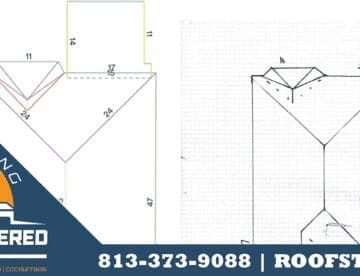Determining the type of sheathing you’ll need to support the roof covering d epends on several things such as the type of roof you are going to install, the slope of the roof, the local climate, the building code requirements etc.
epends on several things such as the type of roof you are going to install, the slope of the roof, the local climate, the building code requirements etc.
Checking the Framing
A problem you may come across is faulty construction on the roof frame, especially at the overhang near the rake. The proper way to build an overhang
is by constructing a lookout rafters also known as a “ladder” to keep the roof from sagging. Sagging overhang can cause roof granules to run off the roof. It is always best to notify the homeowner of this situation and give them a quote to construct a proper overhang when installing the new roof.
When replacing a light roofing system with a heavier type of roofing system you must make sure the roof frame is designed to handle that type of weight. When a roof is overloaded the roof frame may sag. Sagging roofs can stretch asphalt shingles over the rafters causing the granules to come off.
SOLID ROOF SHEATHING
Solid roof sheathing is always needed under and roof that requires continuous support including built-up, shingle, tile, metal (except corrugated steel). Solid sheathing is recommended and often required for all types of roofing systems in climates with wind-driven snow or rains.
It is recommended to install shakes or wood shingles over solid sheathing in areas the outside average low temperature is 0 degrees Fahrenheit or colder, The January mean temperature is 25 degrees Fahrenheit of less, and in areas where there is a possibility the ice will form along the eves causing leaks from backed up water.
You can use 1×4, 1×6, 1×8, 1×10, or 1×12 boards however boards larger the 1×6 tend to expand and shrink with the changing climate once they are installed.
Sheathing boards should be installed with a tight edge joint, however you should allow at least 1/8 inch space for expansion. The edge joints should be staggered and centered over the rafters. It is not recommended to use a square-edge boards when installing built-up or mineral-surfaced roll roofing because individual boards can warp causing the material to split.
Ship-lap and tongue-and-groove lumber is expensive so most contractors just use ply-wood.
Never use “green” or poorly seasoned lumber as wet lumber will eveturally dry up an warp causing the roofing season to wrinkle and buckle.
Never use crap lumber, concrete form lumber, or boards of uneven thickness.
All boards should be securely nailed to the rafters.
Don’t use lumber with loose knots or areas where pitch (tree sap) runs over the board surface because the tree sap reacts with asphalt causing it to dissolve. If you are covering an existing roof with these discrepancies you should cover the defected areas with sheet metal patches before installing the roof.
Most roof sheathing is made of plywood. The American Plywood Association recommends a minimum plywood grade of C-D Interior-and-Exterior Glue, or another equally durable exterior grade plywood and MOST BUILDING CODES REQUIRE IT.
The rafter spacing should be considered when choosing the plywood thickness.
Plywood thickness should at least be 1/2 inch thick for roof sheathing under a built-up roof. The index number shouldn’t be less than 32/16 (unsanded) or Group 1 (sanded). This rating says that the plywood can span a maximum of 32 inches between rafters or 15 inches between floor joints. The face grain should be installed perpendicular to the supports and the sheet should span at least 2 supports.
Some roofing materials such as clay tile can weight as much as 16 lbs per square foot. The APA has a chart that shows the allowable weight of a live load per square foot for the type of plywood being used. For example, a 15/32 sheet of plywood spanning 32 inches between rafters is allowed to hold up to 30 lbs per square foot according to the APA table. If that same sheet of plywood was spanning only 12 inches between supports it could hold up to 325 lbs per square foot. The APA table includes a dead-load weight of 10 pounds per square foot. This dead load is the weight of the roof deck, underlayment, and shingles. If the dead load you are installing is over 10 pounds you must subtract the excess dead load weight from the allowable weight. For example when you install a clay tile of 16 pounds per square foot over a wood deck (3 lbs psf), 30-pound felt (.3 pounds psf), and 90-pound roll roofing (.9 pounds psf) the total dead load is 20.2 pounds meaning that 10.2 lbs would need to be deducted from the allowable live load according to the APA table.
The dead load is the weight of the roofing system, and the live load is the weight loads caused by rain, snow, workers, materials and any other temporary loads.
BUILDING CODES ALLOW A MINIMUM ANTICIPATED LIVE LOAD OF 30 lbs PSF so you need to keep that in mind and calculate the actual dead load weight of the roofing materials and the allowable live load weight remaining.
Support for panel Sheathing
Most manufactures recommend a minimum rafter spacing of 24 inches for a ½ inch sheet of plywood when installing a built-up roof. Blocking should be installed at the unsupported edges of the plywood unless it is tongue-in-groove or you use edge clips. You should use 2x4s (or large) between the rafters for blocking of the unsupported plywood edges. The spacing at the joints should be at least 1/16 inch between edge joints, and 1/8 inch between end-joints.
Waferboard (OSB) can also be used for roof sheating. If you use OSB you must use a minimum 15/32 inch panel.
All decking end-joints should be staggered and should lie on top of the rafter.
The attic should be well ventilated to reduce the possibility of shingle and deck deterioration. This is because moisture in the house moves through the attic. If it is not well ventilated the moisture will collect on the sheathing during cold weather rotting and warping the decking, and during warm weather escaping through the decking resulting in buckling rotten wood and buckling shingles. When an attic is properly ventilated the air circulated and the water dissipates.
Space Board Sheathing
In milder climates you can use spaced sheathing under wood shingles, corrugated metal panel roofs if the building codes allow.
Space sheathing are square -edge 14s for wood shingles, or 1x4s, 1x6s and wider for shakes.
When installing spaced sheathing for wood shingles must install the 1x4s spaced on centers equal to the amount of shingle that will be exposed to the weather. For example if you lay your shingles with 5 ½ inches to the weather, then you 1x4s must be spaced 5-1/2” from the center to center of the sheathing boards as well. You will nail each shingle at the center of each board. Some building codes require that the spacing of the sheathing can’t exceed the width of the board.
Another application for installing wood shingles is to install 1x6s, and to nail 2 rows of shingles to each 1×6 up to 5-1/2 inches of shingle exposure. One row is nailed near the bottom of the 1×6 and the other row is nailed near the top of the 1×6 with the bottom half of the shingle being exposed to the weather up to 5-1/2 inches. The spacing between the 1x6s needs to be equal to the shingle exposure from center to center of each sheathing board.
For Shakes, spaced sheathing will normally be 1x6s. The space between the shakes will be equal to their exposure. DO NOT SPACE THE SHEATHING MORE THE 2-1/2” to prevent sagging into the attic.
WHEN INSTALLING SPACE SHEATHING, YOU MUST INSTALL SOLID SHEATHING FROM THE EAVES OF THE ROOF UP TO 12 to 24 INCHES BEYOND THE INTERIOR WALL LINE OF THE EXTERIOR WALL OF THE BUILDING. You must check the local building code for the required distance. Some building codes may require 36 inches on slopes less than 4 in 12.
It is recommended to install solid sheathing on gable overhangs and 18 inches on each side of the ridge as well which will give you backing to adjust the exposure of the last few shingles.
Some codes allow spaced sheathing under corrugated metal however most require solid sheathing.
THE MINIMUM ROOF SLOPE FOR WOOD SHINGLES & SHAKES is 4 in 12 however you can install wood shingles and shakes on roof of lower slope if you install 2×4 spacers over a built-up roof covering applied to the sheathing and then install 1×4 or 1×6 nailing strips.
Roof Decking
Roofing decking acts are a solid roof deck and as a wood ceiling. It would be used on buildings that require an attractive wood ceiling.
Loading the Roof
Bundles of shingles should be stacked along the ridge and the weight should be distributed as evenly as possible on both sides of the ridge keeping the materials out of the way until they are needed.
Be careful not to overload the roof at the mid-span of the rafters where the decking is weakest.
Roofing tiles should be loaded in stacks of eight along every 4th course except along the ridge where you load in stacks of 4.

